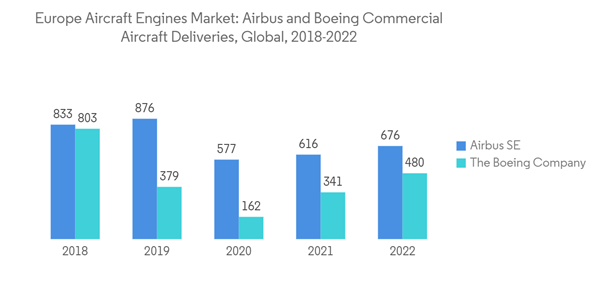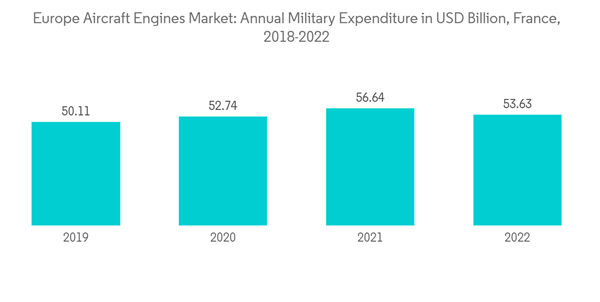The demand for aircraft engines is driven primarily by an increase in the order book of aircraft (business jet, commercial, or military aircraft) or as a replacement for the engines for the existing aircraft fleet. Aircraft OEMs and engine manufacturers are engaging in extensive integration efforts to enhance performance and extend the range of aircraft. The investments towards the R&D of such technologies are anticipated to bolster the market prospects during the forecast period.
The manufacturing cycle of aircraft engine OEMs is expected to undergo rapid transformation due to the increasing use of 3D printing and ceramic matrix composites to construct critical components of an aircraft engine. Aircraft operators are engrossed in employing operational engines with increased fuel efficiency and reduced overall operational costs. This has made aircraft OEMs and engine manufacturers engage in extensive integration efforts to enhance performance and extend the range of aircraft. New engines are technological marvels composed of advanced materials with increased durability to ensure performance without compromising their service life. Furthermore, emerging technologies such as a hybrid-electric jet engine are anticipated to enhance the current business opportunities for the market players.
Europe Aircraft Engines Market Trends
Civil and Commercial Segment Will Showcase Remarkable Growth Due to Increasing Developments In Increasing the Engine Efficiency
Since the advent of commercial aviation, airlines have been engrossed in employing operational engines with increased fuel efficiency and reduced overall operational costs. Thus, the selection of advanced materials with increased durability is preferred to ensure performance without compromising on the service life aspect of aircraft engines. The present generation of engines is digitally controlled, and the power output is controlled using sensors at different levels of flight. Sensors are located at various key locations, and multi-dimensional data such as temperature, pressure, vibration, and oil debris are collected in real time. Aircraft OEMs and engine manufacturers are engaging in extensive integration efforts to enhance performance and extend the range of aircraft. For instance, Pratt & Whitney, a leading aircraft engine manufacturer, has been offering a high-bypass GTF called PW1000G (under the brand name PurePower) as a powerplant option to aircraft such as Embraer's second-generation E-Jets and MRJs. This family of engines incorporates an improved gearbox that empowers the fans to rotate at a slower speed than the blades of the driving internal turbine, leading to increased efficiency. The manufacturer claims that PW1000G can ensure a 12%-15% reduction in fuel consumption, around 15% reduction in CO2 emissions, and a decrease of 50% in nitrogen oxide (NOx) emissions, besides operating with a much lower level of noise. Also, due to the high number of forecasted deliveries, the civil and commercial aviation segment would overshadow the military aviation segment of the market in focus during the forecast period.France to Dominate the Market During the Forecast Period
France has been in global focus for aviation owing to the presence of aircraft manufacturers, like Airbus and Dassault. Despite being a direct competitor in the market studied, the airline has sparked significant interest in aviation in the people of the country and led to a high drive toward private jet or business jet aviation, driving the growth of the market studied. France witnessed a dip in its military budget as well. In 2022, the French Ministry of Defense allocated USD 53.6 billion to its military budget, with a decrease of USD 3 billion decrease over the 2021 enacted budget. Still, the country is aggressively partnering with other nations for engine deals to witness an improved sales bar. For instance, in March 2022, India and France could conclude a joint fighter engine development deal in a couple of months. The deal will see India’s Defense Research and Development Organization and French engine maker Safran collaborate to develop a 125KN (Kilonewton) engine for India’s first indigenous fifth-generation Advanced Medium Combat Aircraft (AMCA), which is under development. Several fleet rationalization steps are seen taken in the French aviation industry. For instance, Air France-KLM airline’s fleet plans to take delivery of 38 Airbus A350s to modernize its long-haul fleet between 2021 and 2025. The airline is currently taking delivery of the A350 aircraft from Airbus. During the period of 2018-2022 till date, France received 373 deliveries for helicopter engines. In addition to this, Arriel 2D dominated the segment, followed by PT6C-67E with net engine deliveries of 318 and 21, respectively, during the same period. Considering these developments, it can be inferred that France has been showcasing its key presence in the military ad civil aviation sectors positively. Thus, the demand for aircraft and helicopter engines is expected to significantly increase over the forecast period.Europe Aircraft Engines Industry Overview
The aircraft engine market in Europe is consolidated in nature, with a handful of engine OEMs such as Safran SA, Rostec, Rolls-Royce plc, Pratt & Whitney (RTX Corporation), General Electric Company, and CFM International dominating the market. Vendors must provide advanced and high-quality gas turbine engines to survive and succeed in the intensely competitive market environment. In-house manufacturing capabilities, a global footprint network, product offerings, R&D investments, and a strong client base are the key areas to have the edge over competitors. Also, engine manufacturers are partnering with aircraft manufacturers to develop sustainable aircraft engine solutions that have low weight and reduced engine emissions. In addition to this, due to increasing demand for local manufacturing, regional players are partnering with international players. Such developments are anticipated to help the companies increase their market presence over the coming years.Additional Benefits:
- The market estimate (ME) sheet in Excel format
- 3 months of analyst support
This product will be delivered within 2 business days.
Table of Contents
Methodology

LOADING...










